F-segment
F-segment, or full-size luxury/high-end luxury is a car classification defined by European Commission.[1] It is a niche of the European market (approx. 0.3%) and the range is limited to only a few models.[2] Typical F-segment cars include the Audi A8, BMW 7 Series, Jaguar XJ, Lexus LS, Genesis G90, Kia Quoris, Maserati Quattroporte and Mercedes-Benz S-Class. Usually the vehicles are large and have four-doors and a traditional boot, but in more recent years, coupés and convertibles, as well as five-door hatchbacks, have started to emerge.
Luxury car saloons, as we recognise them today, can trace their origins back decades with some of the above manufacturers having an unbroken lineage dating back to the 1950s. Mercedes-Benz, for example, offered its unibody 'Ponton' luxury car in 1954, which was a direct predecessor of the first S-Class which appeared in 1972. Jaguar's XJ appeared in 1968, the same year as the precursor (BMW E3) to the BMW 7 Series, which itself debuted in 1977. Audi and Lexus entered the luxury car market in the late 80s with their V8 (later A8) and LS models, respectively.
In South Korea, motoring brands often linked up with long-established foreign car manufacturers to build their first luxury cars. The first Hyundai Equus was developed with Mitsubishi, who released the almost identical Proudia and Dignity models in 1999. The Daewoo Arcadia was a badge engineered Honda/Acura Legend while the initial SsangYong Chairman was heavily based on Mercedes-Benz mechanicals.
Cadillac is the only American manufacturer to officially import some of their luxury cars into Europe, including the fourth and fifth generation Sevilles which were replaced by the STS in 2004 and CT6 in 2016.
Extended wheelbase variants of these cars are common, as many of the luxury features are placed for the rear-seat occupants. In some markets (depending on the manufacturer), short wheelbase models are excluded completely, and only long wheelbase variants are sold.
Ultra-luxury car manufacturers such as Rolls-Royce or Bentley also fit into this segment. Top-spec flagship models that have a V12 engine planted inside such as BMW 760Li or Mercedes-Benz S600 are sometimes classed as ultra-luxury cars.
European sales figures
| 2017 rank | Manufacturer | Model | 2013 sales | 2014 sales | 2015 sales | 2016 sales | 2017 sales | % change (2016–2017) |
|---|---|---|---|---|---|---|---|---|
| 1 | Mercedes-Benz | S-Class | 8,736 | 17,638 | 16,583 | 14,967 | 14,757 | |
| 2 | BMW | 7 Series | 5,980 | 5,307 | 5,985 | 13,320 | 11,533 | |
| 3 | Porsche | Panamera | 5,679 | 5,676 | 4,191 | 3,140 | 10,478 | |
| 4 | Audi | A8 / S8 | 5,486 | 6,556 | 6,717 | 5,372 | 5,887 | |
| 5 | Jaguar | XJ | 2,287 | 1,905 | 1,616 | 1,847 | 1,495 | |
| 6 | Bentley | Flying Spur | 313 | 624 | 555 | 627 | 637 | |
| 7 | Maserati | Quattroporte | 452 | 812 | 815 | 682 | 562 | |
| 8 | Bentley | Mulsanne | 156 | 185 | 209 | 227 | 186 | |
| 9 | Rolls-Royce | Ghost | 255 | 189 | 233 | 180 | 166 | |
| 10 | Aston Martin | Rapide | 250 | 165 | 197 | 108 | 124 | |
| 11 | Rolls-Royce | Phantom | 120 | 105 | 97 | 124 | 95 | |
| 12 | Volkswagen | Phaeton | 1,793 | 1,792 | 1,510 | 160 | 8 | |
| Total | — | — | — | — | — | 40,754 | 45,928 |
Current F-segment cars
_01.jpg) Aston Martin Rapide (2010-)
Aston Martin Rapide (2010-)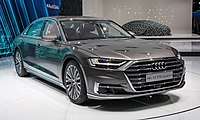 Audi A8 (1994-)
Audi A8 (1994-)_%E2%80%93_Frontansicht%2C_16._August_2014%2C_Essen.jpg) Audi S8 (1996-)
Audi S8 (1996-)%2C_12._August_2013%2C_D%C3%BCsseldorf.jpg) Bentley Flying Spur (2005-)
Bentley Flying Spur (2005-) Bentley Mulsanne (2010-)
Bentley Mulsanne (2010-)_%E2%80%93_Frontansicht%2C_1._Oktober_2016%2C_New_York.jpg) BMW 7 Series (1977-)
BMW 7 Series (1977-)- Bufori Geneva (2010-)
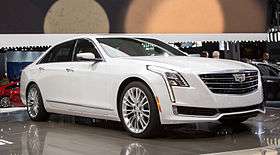 Cadillac CT6 (2016-)
Cadillac CT6 (2016-)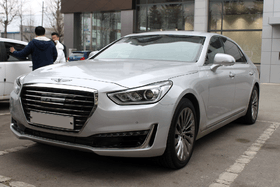 Genesis G90 (2015-)
Genesis G90 (2015-).jpg) Hongqi L5 (2014-)
Hongqi L5 (2014-)_%E2%80%93_Frontansicht%2C_17._Mai_2013%2C_M%C3%BCnster.jpg) Jaguar XJ (1968-)
Jaguar XJ (1968-)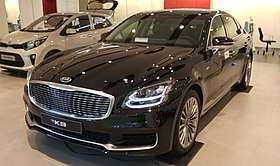 Kia Quoris (2012-)
Kia Quoris (2012-).jpg) Lagonda Taraf (2016-)
Lagonda Taraf (2016-)- Lexus LS (1989-)
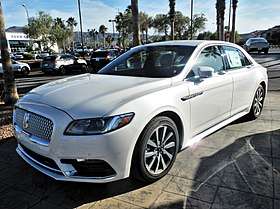 Lincoln Continental (2016-)
Lincoln Continental (2016-)_(cropped).jpg) Maserati Quattroporte (1963-)
Maserati Quattroporte (1963-)- Mercedes-Benz S-Class (1972-)
.jpg) Nissan Cima (1988-)
Nissan Cima (1988-)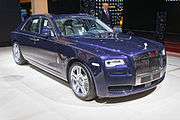 Rolls-Royce Ghost (2010-)
Rolls-Royce Ghost (2010-)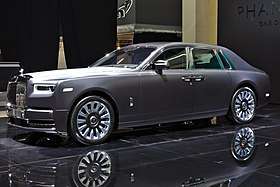 Rolls-Royce Phantom (2017-)
Rolls-Royce Phantom (2017-) Toyota Century (1967-)
Toyota Century (1967-)
2-door models
_%E2%80%93_Frontansicht_(1)%2C_30._August_2011%2C_D%C3%BCsseldorf.jpg) Bentley Continental GT (2003-)
Bentley Continental GT (2003-)_%E2%80%93_Frontansicht_ge%C3%B6ffnet_(2)%2C_25._Oktober_2011%2C_D%C3%BCsseldorf.jpg) Bentley Continental GTC (2006-)
Bentley Continental GTC (2006-).jpg) Mercedes-Benz C217 (2014-)
Mercedes-Benz C217 (2014-).jpg) Mercedes-Benz A217 (2015-)
Mercedes-Benz A217 (2015-)_coupe_(2015-07-25)_01.jpg) Rolls-Royce Wraith (2013-)
Rolls-Royce Wraith (2013-).jpg) Rolls-Royce Dawn (2015-)
Rolls-Royce Dawn (2015-)
See also
References
- ↑ "REGULATION (EEC) No 4064/89 - MERGER PROCEDURE" (PDF). Office for Official Publications of the European Communities L-2985 Luxembourg.
- ↑ "European car sales analysis March 2015 – models". Left Lane.
- ↑ http://carsalesbase.com/european-sales-2017-limousine-segment/